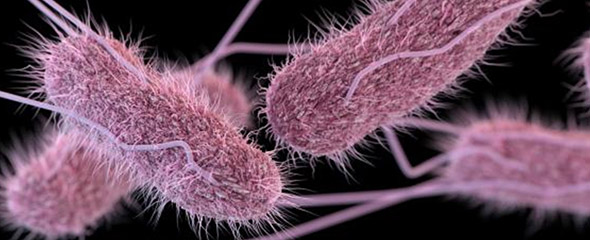The flagellums’ long, external filament is composed of several thousand copies of the same protein known as flagellin. The Gram-negative bacteria Salmonella Typhimurium express two distinct flagellins, FliC and FljB, which undergo the methylation of their lysine residues via the enzyme FliB. While this modification of the flagellin’s surface published in the 1950’s was the first reported protein methylation, the reason behind this process has until now remained elusive.
Based on both in vivo and in vitro studies, the CSSB-based HZI department “Structural Infection biology” lead by Prof. Michael Kolbe in collaboration with former HZI group leader Prof. Marc Erhardt, now at the Humboldt University of Berlin, found that methylation of flagella facilitates adhesion of Salmonella Typhimurium to hydrophobic cell surfaces. Thus, the methylation of flagella plays an important role for the host invasion process. “The methylated lysine residues are conserved and primarily located in the surface-exposed domains of flagellins. In the mouse model, we were able to show that methylated flagella enhance the efficient colonization of the intestinal tissue,” says Dr Michele Lunelli, one of the publication’s main authors “Methylated flagella are therefore crucial for the progression of the infection.” Subsequent analysis showed that methylation increases the surface hydrophobicity of flagella and therefore enhances adhesion to host cells. The crystal structure of FljB, presented in this paper, allowed the characterization of the methylation sites on the flagellar surface.
The modification of flagellin occurs not only in Salmonella but also in several other bacterial species. “This suggests that methylation of flagella might represent a general mechanism that facilitates adhesion to host cells for different bacterial pathogens,” says Kolbe “It’s quite exciting that this long-term collaboration between the research groups has resulted in what may be a new role for the bacterial flagellar function.” This insight into flagella’s role in host cell invasion may ultimately provide scientists with a novel therapeutic target. More specifically, molecular insights into the structure of the flagellin subunits that assemble the flagella filament could contribute to the design of specific inhibitors, which would prevent methylation and hamper host invasion.
Original publication:
Julia A. Horstmann*, Michele Lunelli*, Hélène Cazzola, Johannes Heidemann, Caroline Kühne, Pascal Steffen, Sandra Szefs, Claire Rossi, Ravi K. Lokareddy, Chu Wang, Laurine Lemaire, Kelly T. Hughes, Charlotte Uetrecht, Hartmut Schlüter, Guntram A. Grass, Theresia E. B. Stradal, Yannick Rossez, Michael Kolbe & Marc Erhardt: Methylation of Salmonella Typhimurium flagella promotes bacterial adhesion and host cell invasion. Nature Communications. 2020; DOI: 10.1038/s41467-020-15738-3
(* these authors contributed equally)
